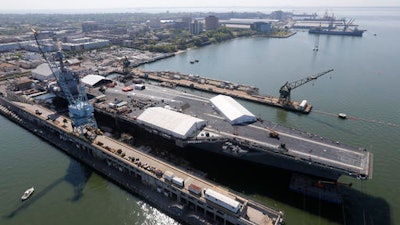
NEWPORT NEWS, Va. (AP) — The Navy refers to its newest aircraft carrier, the USS Gerald R. Ford, as "4.5 acres of sovereign U.S. territory." The $12.9 billion warship — the first of the Navy's next generation of aircraft carriers — is in the final stages of construction after cost overruns and a delay of more than one year (see photos in gallery).
This carrier and those that will follow, including the USS John F. Kennedy and the USS Enterprise, will replace the Nimitz-class carriers, which were first commissioned in 1975. Construction on the Ford started in 2009 and on the Kennedy in 2015. Construction is scheduled to start on the Enterprise in 2018, but that could be pushed back.
The Ford — sitting now at Newport News Shipbuilding, the giant Navy contractor in Virginia — will house about 2,600 sailors, 600 fewer than the Nimitz-class carriers. The Navy says that will save more than $4 billion over the ship's 50-year lifespan. The air wing to support the Ford could add more personnel to the ship, which is designed to house more than 4,600 crew members.
The Navy had hoped to begin testing the Ford's systems and equipment during sea trials this fall. But those tests and a delivery date have been delayed as work continues on some of the vessel's new technology, such as its power generation system, aircraft landing equipment and advanced weapons elevators.
Construction was supposed to be completed by September 2015, with a cost cap of $10.5 billion. The Navy has attributed delays and cost overruns to the ship's state-of-the-art systems and technology.
Capt. Richard McCormick took command of the Ford last spring and will be at the helm for sea trials when they are scheduled.
The ship's destination once it's delivered to the Navy? "Bottom line is that when the ship is ready for deployment, we will go where the boss tells us to go," McCormick says.
Technology
The vessel includes electromagnetic launch systems for jets and drones, replacing steam catapults; a smaller island that sits farther back on the ship, making it easier and quicker to refuel, re-arm and relaunch planes; and a nuclear power plant designed to allow cruising speeds of more than 30 knots and operation for 20 years without refueling.
Captain's Cabin
The in-port cabin reflects the life and career of the ship's namesake, President Gerald R. Ford. Besides living quarters, the cabin serves as a ceremonial receiving location for distinguished guests and as an area for the captain to welcome new sailors aboard. Morning meetings are held in the suite's boardroom.
Anchor Room & Hangar Bay
The Ford weighs close to 100,000 tons and getting it to rest dead in the water requires some serious stopping power. Hours of planning go into dropping anchor, but when the brake is released and the anchor starts to drop, it happens fast: 90 feet of chain can pay out in 5 seconds.
Daily Life
Below deck on the ship is a maze of steel hatches and heavily plated hallways that descend 11 levels, revealing the workings of a small city - a medical ward, barber shops, fitness centers, living quarters, fire stations and more.
Routine tasks are punctuated aboard the Ford with "general quarter" drills: Sirens blare and sailors scramble to defensive positions, sealing hatches and assembling near repair lockers.






















